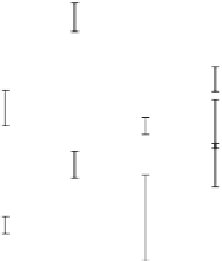Agriculture Reference
In-Depth Information
2015, Chapter 6 in this volume), using NO
3
−
rather than O
2
as a terminal electron
acceptor during respiration when O
2
is in short supply.
In well-aerated soils, denitrification mainly occurs within soil aggregates and par-
ticles of organic matter, where O
2
is depleted because its consumption by microbial
activity is faster than its replacement by diffusion (Sexstone et al. 1985). Other fac-
tors can also be important, including denitrifier community composition (Schmidt
and Waldron 2015, Chapter 6 in this volume). Cavigelli and Robertson (2000, 2001),
for example, found numerically dominant denitrifying taxa in MCSE Conventional
system soils that were absent in Mown Grassland (never tilled) soils, and vice versa.
They also found that taxa differed in the sensitivities of their Nos enzymes to O
2
,
and thus in their abilities to reduce N
2
O to N
2
under identical C, NO
3
−
, and O
2
condi-
tions (Fig. 9.8). This study provided an early example of the importance of micro-
bial diversity for ecosystem function, which has subsequently become an important
research topic (Schmidt and Waldron 2015, Chapter 6 in this volume).
Denitrification in normally unsaturated soils is highly episodic, occurring pri-
marily after wetting events that create anoxic microsites in soil layers where NO
3
−
and labile C are abundant. Because denitrifying enzymes are induced sequentially,
there can be a lag period just after wetting when N
2
O is a dominant end product
(Robertson 2000). Bergsma et al. (2002), for example, used
15
N tracers at KBS to
show that in soils from the Conventional system, the N
2
O mole fraction ((N
2
O/[N
2
O +
N
2
]) after a wetting event depended on whether or not the soils had been wetted
1.0
0.8
Conventional, pH 5.7
Conventional, pH 6.6 (Native)
Mown Grassland, pH 5.7
Mown Grassland, pH 6.9 (Native)
0.6
0.4
0.2
0
0
0.05 0.10 0.15
Oxygen Added (mL)
Figure 9.8
. N
2
O as a proportion of total N gas production (N
2
O / [N
2
O + N
2
]) at four oxygen
and two pH levels (native and adjusted) for soil from the Conventional and Mown Grassland
(never tilled) MCSE systems. Mean ± SE (n = 3 for Conventional; n = 2 for Mown Grassland
systems). Redrawn from Cavigelli et al. (2000) with permission of the Ecological Society of
America; permission conveyed through Copyright Clearance Center, Inc.
























